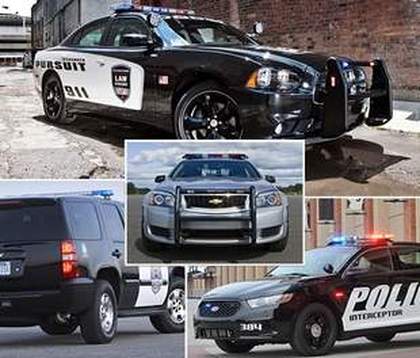
GM and Chrysler have three vehicles each — a mix of SUVs, trucks and sedans — that they hope will earn their stripes. But Ford hopes to preserve the Crown Victoria's 70 percent market share with two rookies modeled on the Ford Taurus and Ford Explorer.
Police fleet sales help automakers achieve high visibility and a reputation for producing durable cars. While overall sales numbers are relatively small, sticker prices can reach $70,000 per police vehicle.
The Big Three's lineup of six pursuit vehicles is the strongest offering in recent years, according to Sgt. Jim Flegel of the Michigan State Police's precision driving unit, which road-tests police vehicles annually. After testing last fall, state police decided to replace the Crown Victoria with Chrysler's Dodge Charger Pursuit as its primary patrol car. In March, the state police ordered 198 Charger Pursuits, as well as 50 Chevy Tahoes and 20 Ford Police Interceptor Utilities, Flegel said.
"The patrol cars are increasingly getting better every year," Flegel said. "All the manufacturers want to produce the best-quality patrol car out there."
It's too early for hard sales numbers, but the Chicago Police Department recently said it would spend $3.5 million on 100 Ford Police Interceptor sedans and SUVs made at Ford's Chicago Assembly Plant.
The shakeup comes as the police vehicle industry records declining sales. Sales were about 35,000 units last year, compared to a peak of about 55,000 units in 2006, according to Lisa Teed, Ford Police Interceptor marketing manager.
But the market is ripe for Ford and its rivals: Several police agencies that held off buying new cars during the economic downturn are ready to invest in new patrol vehicles.
Some police departments stockpiled the Crown Vics before Ford's final production run. They liked the car's rear-wheel drive for high-speed chases. And its body-on-frame structure made it easier to fix and swap parts within the fleet.
The Sacramento Police Department, for example, recently ordered 30 to 50 of the same Crown Vics its officers have driven for years, said Sgt. Andrew Pettit. The department hasn't decided which vehicles it will order when it comes time to retire its fleet.
Crown: 'A dinosaur' Ford canceled the Crown Vic because it would have been too expensive to comply with new standards for fuel economy and rollover and roof crush protection, according to Aaron Bragman, a senior analyst with IHS Automotive.
"In order to update it, they'd pretty much have to redo the entire car," Bragman said. "It's kind of a dinosaur, and to update it wouldn't be worth it."
The Charger Pursuit, created for police use only, went on sale last spring to replace the Charger Police Vehicle. Chrysler added two special service vehicles — a Ram truck and Durango SUV — that will be sold later this year to broaden the automaker's reach and cater to officers who need to go off road or carry cargo.
"Of course we saw an opportunity in the market" with the retirement of the Crown Victoria, said Chris Ellis, Chrysler director of government fleet sales and operations.
The Durango will compete against Chevy's Tahoe, which dominates the police SUV market.
General Motors hopes to gain share in each market segment with its 2012 Chevrolet Tahoe, Impala and Caprice models, said Dana Hammer, manager for law enforcement vehicles. "We have a complete portfolio of vehicles to meet every customer's needs," Hammer said.
The Chevy Tahoe is "growing exponentially" and has the advantage of being the market's only body-on-frame model, Hammer said. The model comes in rear-wheel drive for high-speed pursuit vehicles, and four-wheel-drive for special service.
The Chevy Caprice, resurrected last year after being discontinued in 1996, is the largest sedan in the police market and is gaining sales momentum, Hammer said. Like the other automakers, he would not disclose sales figures.
The third GM police vehicle, the Chevy Impala, has been a police department staple for 10 years.
Its new powertrain and chassis for 2012 is the most economical model, with a 3.6-liter V6 engine that gets 28 miles per gallon, according to Hammer.
Ford has advantage Ford is promoting its Police Interceptor models for their fuel efficiency: The 3.5-liter, V6 engine in the Ford Police Interceptor sedan and utility vehicle get at least 25 percent better gas mileage than the Crown Vic's 4.6-liter V8 — an especially significant feature since police cars idle an average of 6.5 hours every 10-hour shift.
"We're very confident in what they're doing," said Kevin Koswick, Ford North America fleet director. "Make no mistake about it. Our goal is to maintain our business."
Analysts say it's too soon to tell how the market will shake out this year, but Ford has the advantage of being an incumbent with a loyal following.
Ford's task is to convince buyers that the Dearborn automaker's models still reign supreme, Bragman said.
"The fleet buyers are fairly loyal," Bragman said.
 RSS Feed
RSS Feed
